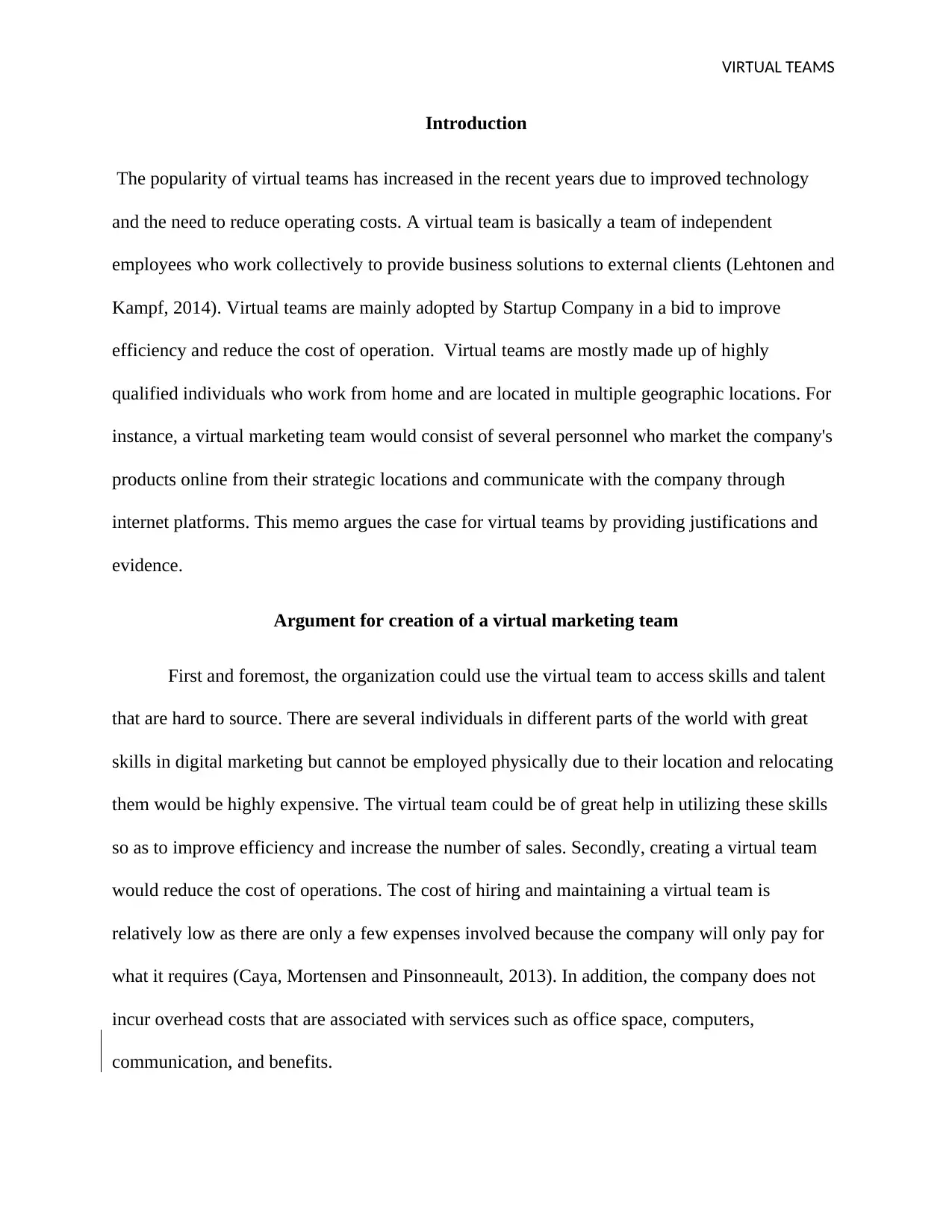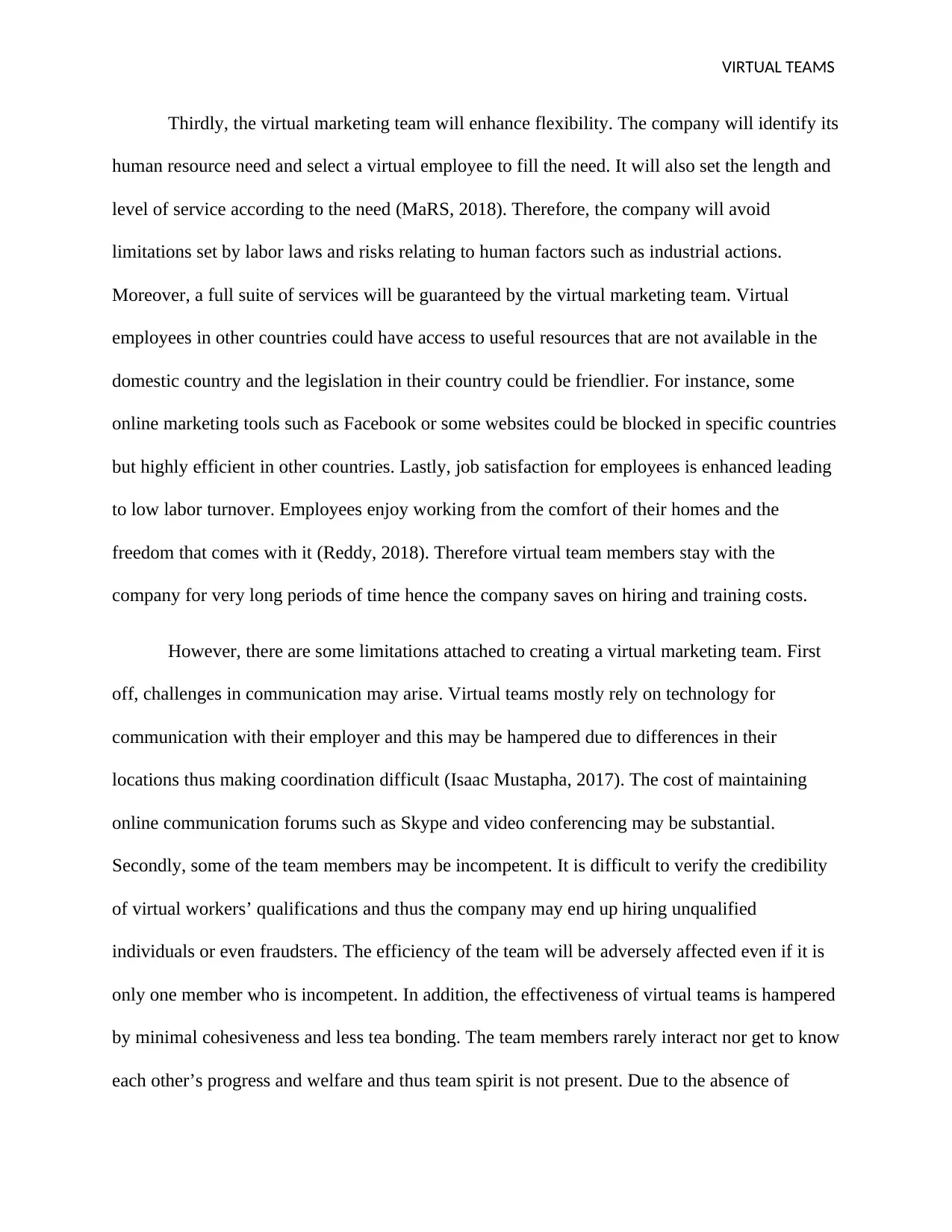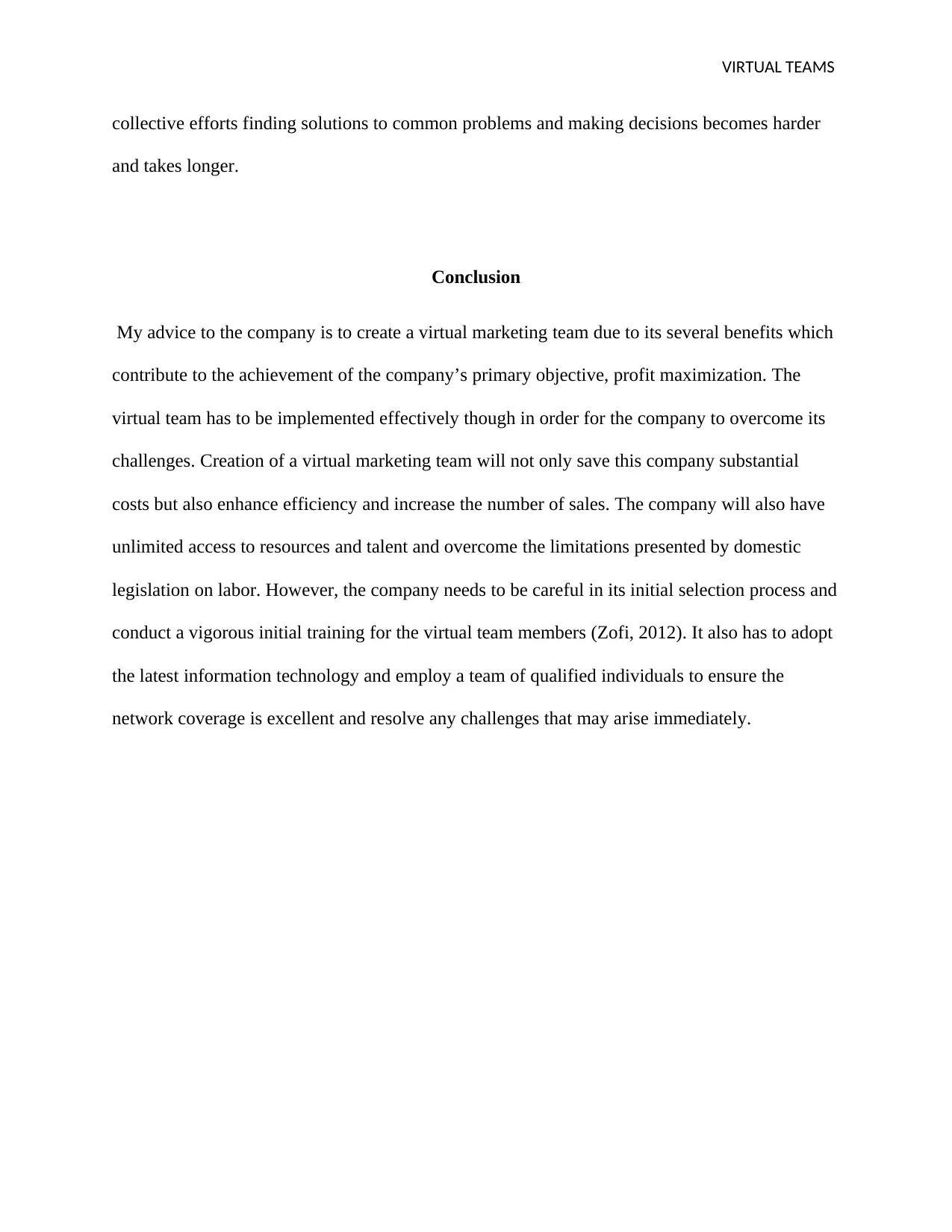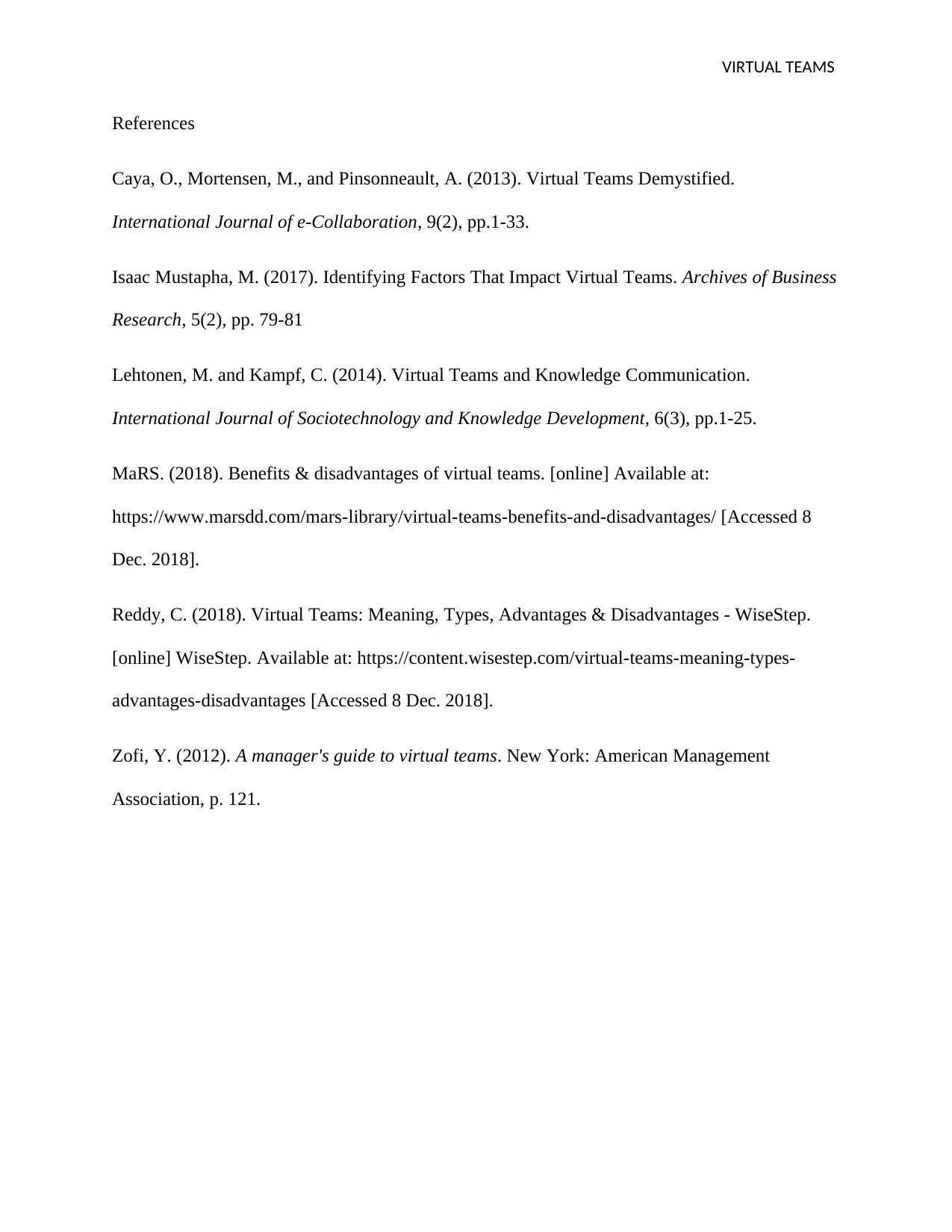Assessing Virtual Marketing Team Feasibility at Company XYZ
VerifiedAdded on 2023/05/28
|5
|1074
|250
Report
AI Summary
This report examines the potential of creating a virtual marketing team for Company XYZ, considering benefits such as access to global talent, reduced operational costs, enhanced flexibility, and improved job satisfaction. It also addresses potential challenges, including communication difficulties, team member competence, and reduced team cohesiveness. The report concludes by recommending the implementation of a virtual marketing team, emphasizing the importance of careful selection, thorough training, and robust IT infrastructure to mitigate potential drawbacks and maximize the team's effectiveness in achieving the company's profit maximization goals. Desklib provides students access to similar assignments and past papers.

VIRTUAL TEAMS
Virtual Teams
Student’s Name
Instructor’s Name
Course Number
Date
Virtual Teams
Student’s Name
Instructor’s Name
Course Number
Date
Paraphrase This Document
Need a fresh take? Get an instant paraphrase of this document with our AI Paraphraser

VIRTUAL TEAMS
Introduction
The popularity of virtual teams has increased in the recent years due to improved technology
and the need to reduce operating costs. A virtual team is basically a team of independent
employees who work collectively to provide business solutions to external clients (Lehtonen and
Kampf, 2014). Virtual teams are mainly adopted by Startup Company in a bid to improve
efficiency and reduce the cost of operation. Virtual teams are mostly made up of highly
qualified individuals who work from home and are located in multiple geographic locations. For
instance, a virtual marketing team would consist of several personnel who market the company's
products online from their strategic locations and communicate with the company through
internet platforms. This memo argues the case for virtual teams by providing justifications and
evidence.
Argument for creation of a virtual marketing team
First and foremost, the organization could use the virtual team to access skills and talent
that are hard to source. There are several individuals in different parts of the world with great
skills in digital marketing but cannot be employed physically due to their location and relocating
them would be highly expensive. The virtual team could be of great help in utilizing these skills
so as to improve efficiency and increase the number of sales. Secondly, creating a virtual team
would reduce the cost of operations. The cost of hiring and maintaining a virtual team is
relatively low as there are only a few expenses involved because the company will only pay for
what it requires (Caya, Mortensen and Pinsonneault, 2013). In addition, the company does not
incur overhead costs that are associated with services such as office space, computers,
communication, and benefits.
Introduction
The popularity of virtual teams has increased in the recent years due to improved technology
and the need to reduce operating costs. A virtual team is basically a team of independent
employees who work collectively to provide business solutions to external clients (Lehtonen and
Kampf, 2014). Virtual teams are mainly adopted by Startup Company in a bid to improve
efficiency and reduce the cost of operation. Virtual teams are mostly made up of highly
qualified individuals who work from home and are located in multiple geographic locations. For
instance, a virtual marketing team would consist of several personnel who market the company's
products online from their strategic locations and communicate with the company through
internet platforms. This memo argues the case for virtual teams by providing justifications and
evidence.
Argument for creation of a virtual marketing team
First and foremost, the organization could use the virtual team to access skills and talent
that are hard to source. There are several individuals in different parts of the world with great
skills in digital marketing but cannot be employed physically due to their location and relocating
them would be highly expensive. The virtual team could be of great help in utilizing these skills
so as to improve efficiency and increase the number of sales. Secondly, creating a virtual team
would reduce the cost of operations. The cost of hiring and maintaining a virtual team is
relatively low as there are only a few expenses involved because the company will only pay for
what it requires (Caya, Mortensen and Pinsonneault, 2013). In addition, the company does not
incur overhead costs that are associated with services such as office space, computers,
communication, and benefits.

VIRTUAL TEAMS
Thirdly, the virtual marketing team will enhance flexibility. The company will identify its
human resource need and select a virtual employee to fill the need. It will also set the length and
level of service according to the need (MaRS, 2018). Therefore, the company will avoid
limitations set by labor laws and risks relating to human factors such as industrial actions.
Moreover, a full suite of services will be guaranteed by the virtual marketing team. Virtual
employees in other countries could have access to useful resources that are not available in the
domestic country and the legislation in their country could be friendlier. For instance, some
online marketing tools such as Facebook or some websites could be blocked in specific countries
but highly efficient in other countries. Lastly, job satisfaction for employees is enhanced leading
to low labor turnover. Employees enjoy working from the comfort of their homes and the
freedom that comes with it (Reddy, 2018). Therefore virtual team members stay with the
company for very long periods of time hence the company saves on hiring and training costs.
However, there are some limitations attached to creating a virtual marketing team. First
off, challenges in communication may arise. Virtual teams mostly rely on technology for
communication with their employer and this may be hampered due to differences in their
locations thus making coordination difficult (Isaac Mustapha, 2017). The cost of maintaining
online communication forums such as Skype and video conferencing may be substantial.
Secondly, some of the team members may be incompetent. It is difficult to verify the credibility
of virtual workers’ qualifications and thus the company may end up hiring unqualified
individuals or even fraudsters. The efficiency of the team will be adversely affected even if it is
only one member who is incompetent. In addition, the effectiveness of virtual teams is hampered
by minimal cohesiveness and less tea bonding. The team members rarely interact nor get to know
each other’s progress and welfare and thus team spirit is not present. Due to the absence of
Thirdly, the virtual marketing team will enhance flexibility. The company will identify its
human resource need and select a virtual employee to fill the need. It will also set the length and
level of service according to the need (MaRS, 2018). Therefore, the company will avoid
limitations set by labor laws and risks relating to human factors such as industrial actions.
Moreover, a full suite of services will be guaranteed by the virtual marketing team. Virtual
employees in other countries could have access to useful resources that are not available in the
domestic country and the legislation in their country could be friendlier. For instance, some
online marketing tools such as Facebook or some websites could be blocked in specific countries
but highly efficient in other countries. Lastly, job satisfaction for employees is enhanced leading
to low labor turnover. Employees enjoy working from the comfort of their homes and the
freedom that comes with it (Reddy, 2018). Therefore virtual team members stay with the
company for very long periods of time hence the company saves on hiring and training costs.
However, there are some limitations attached to creating a virtual marketing team. First
off, challenges in communication may arise. Virtual teams mostly rely on technology for
communication with their employer and this may be hampered due to differences in their
locations thus making coordination difficult (Isaac Mustapha, 2017). The cost of maintaining
online communication forums such as Skype and video conferencing may be substantial.
Secondly, some of the team members may be incompetent. It is difficult to verify the credibility
of virtual workers’ qualifications and thus the company may end up hiring unqualified
individuals or even fraudsters. The efficiency of the team will be adversely affected even if it is
only one member who is incompetent. In addition, the effectiveness of virtual teams is hampered
by minimal cohesiveness and less tea bonding. The team members rarely interact nor get to know
each other’s progress and welfare and thus team spirit is not present. Due to the absence of
⊘ This is a preview!⊘
Do you want full access?
Subscribe today to unlock all pages.

Trusted by 1+ million students worldwide

VIRTUAL TEAMS
collective efforts finding solutions to common problems and making decisions becomes harder
and takes longer.
Conclusion
My advice to the company is to create a virtual marketing team due to its several benefits which
contribute to the achievement of the company’s primary objective, profit maximization. The
virtual team has to be implemented effectively though in order for the company to overcome its
challenges. Creation of a virtual marketing team will not only save this company substantial
costs but also enhance efficiency and increase the number of sales. The company will also have
unlimited access to resources and talent and overcome the limitations presented by domestic
legislation on labor. However, the company needs to be careful in its initial selection process and
conduct a vigorous initial training for the virtual team members (Zofi, 2012). It also has to adopt
the latest information technology and employ a team of qualified individuals to ensure the
network coverage is excellent and resolve any challenges that may arise immediately.
collective efforts finding solutions to common problems and making decisions becomes harder
and takes longer.
Conclusion
My advice to the company is to create a virtual marketing team due to its several benefits which
contribute to the achievement of the company’s primary objective, profit maximization. The
virtual team has to be implemented effectively though in order for the company to overcome its
challenges. Creation of a virtual marketing team will not only save this company substantial
costs but also enhance efficiency and increase the number of sales. The company will also have
unlimited access to resources and talent and overcome the limitations presented by domestic
legislation on labor. However, the company needs to be careful in its initial selection process and
conduct a vigorous initial training for the virtual team members (Zofi, 2012). It also has to adopt
the latest information technology and employ a team of qualified individuals to ensure the
network coverage is excellent and resolve any challenges that may arise immediately.
Paraphrase This Document
Need a fresh take? Get an instant paraphrase of this document with our AI Paraphraser

VIRTUAL TEAMS
References
Caya, O., Mortensen, M., and Pinsonneault, A. (2013). Virtual Teams Demystified.
International Journal of e-Collaboration, 9(2), pp.1-33.
Isaac Mustapha, M. (2017). Identifying Factors That Impact Virtual Teams. Archives of Business
Research, 5(2), pp. 79-81
Lehtonen, M. and Kampf, C. (2014). Virtual Teams and Knowledge Communication.
International Journal of Sociotechnology and Knowledge Development, 6(3), pp.1-25.
MaRS. (2018). Benefits & disadvantages of virtual teams. [online] Available at:
https://www.marsdd.com/mars-library/virtual-teams-benefits-and-disadvantages/ [Accessed 8
Dec. 2018].
Reddy, C. (2018). Virtual Teams: Meaning, Types, Advantages & Disadvantages - WiseStep.
[online] WiseStep. Available at: https://content.wisestep.com/virtual-teams-meaning-types-
advantages-disadvantages [Accessed 8 Dec. 2018].
Zofi, Y. (2012). A manager's guide to virtual teams. New York: American Management
Association, p. 121.
References
Caya, O., Mortensen, M., and Pinsonneault, A. (2013). Virtual Teams Demystified.
International Journal of e-Collaboration, 9(2), pp.1-33.
Isaac Mustapha, M. (2017). Identifying Factors That Impact Virtual Teams. Archives of Business
Research, 5(2), pp. 79-81
Lehtonen, M. and Kampf, C. (2014). Virtual Teams and Knowledge Communication.
International Journal of Sociotechnology and Knowledge Development, 6(3), pp.1-25.
MaRS. (2018). Benefits & disadvantages of virtual teams. [online] Available at:
https://www.marsdd.com/mars-library/virtual-teams-benefits-and-disadvantages/ [Accessed 8
Dec. 2018].
Reddy, C. (2018). Virtual Teams: Meaning, Types, Advantages & Disadvantages - WiseStep.
[online] WiseStep. Available at: https://content.wisestep.com/virtual-teams-meaning-types-
advantages-disadvantages [Accessed 8 Dec. 2018].
Zofi, Y. (2012). A manager's guide to virtual teams. New York: American Management
Association, p. 121.
1 out of 5
Related Documents
Your All-in-One AI-Powered Toolkit for Academic Success.
+13062052269
info@desklib.com
Available 24*7 on WhatsApp / Email
![[object Object]](/_next/static/media/star-bottom.7253800d.svg)
Unlock your academic potential
Copyright © 2020–2025 A2Z Services. All Rights Reserved. Developed and managed by ZUCOL.




